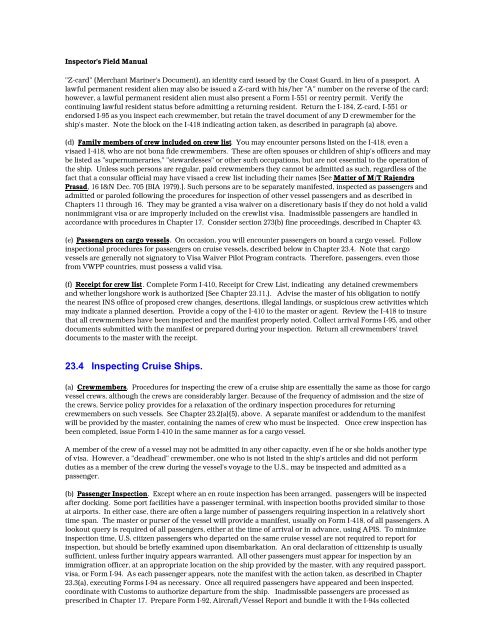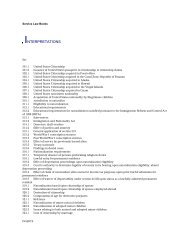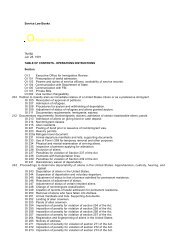You also want an ePaper? Increase the reach of your titles
YUMPU automatically turns print PDFs into web optimized ePapers that Google loves.
<strong>Inspector's</strong> <strong>Field</strong> <strong>Manual</strong><br />
"Z-card" (Merchant Mariner's Document), an identity card issued by the Coast Guard, in lieu of a passport. A<br />
lawful permanent resident alien may also be issued a Z-card with his/her "A" number on the reverse of the card;<br />
however, a lawful permanent resident alien must also present a Form I-551 or reentry permit. Verify the<br />
continuing lawful resident status before admitting a returning resident. Return the I-184, Z-card, I-551 or<br />
endorsed I-95 as you inspect each crewmember, but retain the travel document of any D crewmember for the<br />
ship's master. Note the block on the I-418 indicating action taken, as described in paragraph (a) above.<br />
(d) Family members of crew included on crew list. You may encounter persons listed on the I-418, even a<br />
visaed I-418, who are not bona fide crewmembers. These are often spouses or children of ship's officers and may<br />
be listed as "supernumeraries," "stewardesses" or other such occupations, but are not essential to the operation of<br />
the ship. Unless such persons are regular, paid crewmembers they cannot be admitted as such, regardless of the<br />
fact that a consular official may have visaed a crew list including their names [See Matter of M/T Rajendra<br />
Prasad, 16 I&N Dec. 705 (BIA 1979).]. Such persons are to be separately manifested, inspected as passengers and<br />
admitted or paroled following the procedures for inspection of other vessel passengers and as described in<br />
Chapters 11 through 16. They may be granted a visa waiver on a discretionary basis if they do not hold a valid<br />
nonimmigrant visa or are improperly included on the crewlist visa. Inadmissible passengers are handled in<br />
accordance with procedures in Chapter 17. Consider section 273(b) fine proceedings, described in Chapter 43.<br />
(e) Passengers on cargo vessels. On occasion, you will encounter passengers on board a cargo vessel. Follow<br />
inspectional procedures for passengers on cruise vessels, described below in Chapter 23.4. Note that cargo<br />
vessels are generally not signatory to Visa Waiver Pilot Program contracts. Therefore, passengers, even those<br />
from VWPP countries, must possess a valid visa.<br />
(f) Receipt for crew list. Complete Form I-410, Receipt for Crew List, indicating any detained crewmembers<br />
and whether longshore work is authorized [See Chapter 23.11.). Advise the master of his obligation to notify<br />
the nearest INS office of proposed crew changes, desertions, illegal landings, or suspicious crew activities which<br />
may indicate a planned desertion. Provide a copy of the I-410 to the master or agent. Review the I-418 to insure<br />
that all crewmembers have been inspected and the manifest properly noted. Collect arrival Forms I-95, and other<br />
documents submitted with the manifest or prepared during your inspection. Return all crewmembers' travel<br />
documents to the master with the receipt.<br />
23.4 Inspecting Cruise Ships.<br />
(a) Crewmembers. Procedures for inspecting the crew of a cruise ship are essentially the same as those for cargo<br />
vessel crews, although the crews are considerably larger. Because of the frequency of admission and the size of<br />
the crews, Service policy provides for a relaxation of the ordinary inspection procedures for returning<br />
crewmembers on such vessels. See Chapter 23.2(a)(5), above. A separate manifest or addendum to the manifest<br />
will be provided by the master, containing the names of crew who must be inspected. Once crew inspection has<br />
been completed, issue Form I-410 in the same manner as for a cargo vessel.<br />
A member of the crew of a vessel may not be admitted in any other capacity, even if he or she holds another type<br />
of visa. However, a "deadhead" crewmember, one who is not listed in the ship's articles and did not perform<br />
duties as a member of the crew during the vessel's voyage to the U.S., may be inspected and admitted as a<br />
passenger.<br />
(b) Passenger Inspection. Except where an en route inspection has been arranged, passengers will be inspected<br />
after docking. Some port facilities have a passenger terminal, with inspection booths provided similar to those<br />
at airports. In either case, there are often a large number of passengers requiring inspection in a relatively short<br />
time span. The master or purser of the vessel will provide a manifest, usually on Form I-418, of all passengers. A<br />
lookout query is required of all passengers, either at the time of arrival or in advance, using APIS. To minimize<br />
inspection time, U.S. citizen passengers who departed on the same cruise vessel are not required to report for<br />
inspection, but should be briefly examined upon disembarkation. An oral declaration of citizenship is usually<br />
sufficient, unless further inquiry appears warranted. All other passengers must appear for inspection by an<br />
immigration officer, at an appropriate location on the ship provided by the master, with any required passport,<br />
visa, or Form I-94. As each passenger appears, note the manifest with the action taken, as described in Chapter<br />
23.3(a), executing Forms I-94 as necessary. Once all required passengers have appeared and been inspected,<br />
coordinate with Customs to authorize departure from the ship. Inadmissible passengers are processed as<br />
prescribed in Chapter 17. Prepare Form I-92, Aircraft/Vessel Report and bundle it with the I-94s collected




